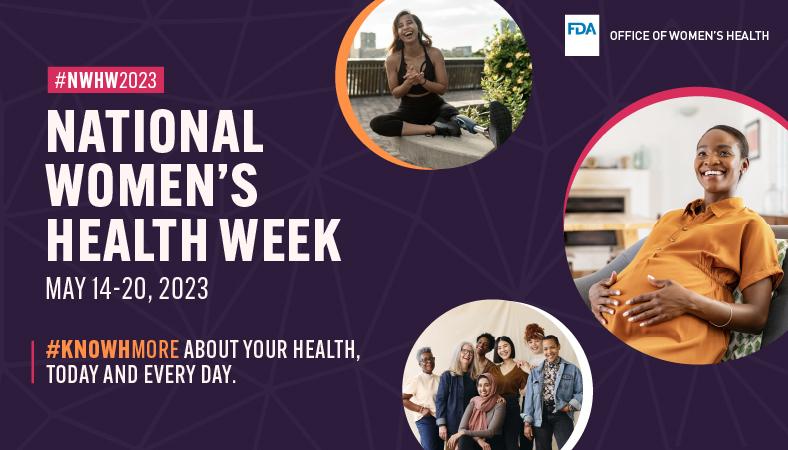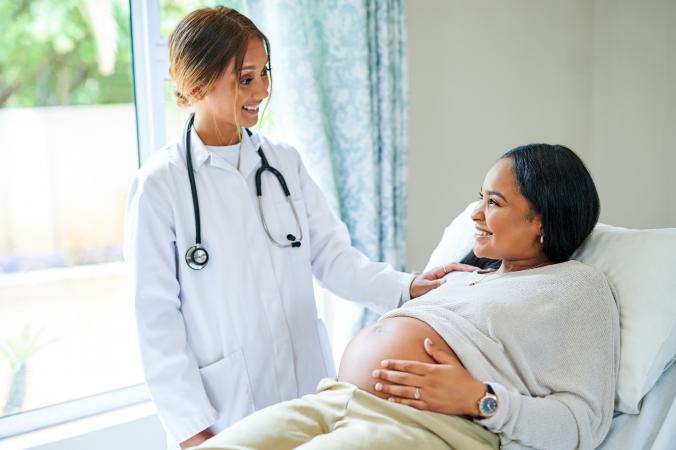National Women's Health Week (NWHW) 2023
National Women’s Health Week (NWHW) is an annual observance that begins on Mother’s Day, May 14th, and runs through May 20th. The FDA Office of Women’s Health (OWH) theme for NWHW 2023 is to encourage women to #KNOWHmore About Your Health, Today and Every Day.
Check out resources from FDA OWH and other federal partners on important women’s health topics below.
- Women’s Health and Wellness
- Pregnancy
- Uterine Fibroids
- Polycystic Ovary Syndrome (PCOS)
- Endometriosis
- Menopause
- Osteoporosis
Women’s Health and Wellness
It can be easy to prioritize the health and wellbeing of your loved ones first, but it is important to take control of your health too. Health screenings, such as pap smears and mammograms are an important way to help recognize health problems, sometimes before there are any signs or symptoms. Ask your health care provider which health screenings are right for you and find out how often you should get screened. From exercising and making healthy food choices to managing health conditions such as high blood pressure and diabetes, you can take steps toward good overall health every day. Check out the resources below to #KNOWHmore about healthy living.
Resources
Are You Up to Date on Your Preventive Care? | CDC
Healthy Living by Age | HHS Office on Women's Health
How You Can Prevent Chronic Diseases | CDC
Caring for Others: Resources to Help You | FDA
Pregnancy
Pregnancy can be a joyous time in a woman’s life. There are many things an expectant mother must #KNOWHmore about for a safe and healthy pregnancy. FDA OWH has resources to help you learn more about what you need to consider during pregnancy. This includes learning more about food safety for moms to be to prevent foodborne illnesses, understanding which medicines are safe to use during pregnancy, child birth and what steps to take to safely use breast pumps and store breast milk.
Many women need to take medicines when they are pregnant. There are about six million pregnancies in the U.S. each year, and 80% of pregnant women say that they take at least one medicine. Some women may be getting treatment for a health problem they had before pregnancy, while others take medicines for health problems, like diabetes, morning sickness, or high blood pressure, that can start or worsen during pregnancy. Some women take medicines or get a vaccine before they find out they are pregnant. By enrolling in a pregnancy exposure registry, you can share your experience with taking medicines or vaccines during pregnancy. This can help other pregnant women and their health care providers learn more about the safety of medications and vaccines used during pregnancy. Always talk with your doctor, nurse, or pharmacist before taking any medicines, vaccines, vitamins, or herbs. Don't stop taking your prescription medicines unless your health care provider says that it is OK. #KNOWHmore about medicine and pregnancy.
Resources
Food Safety for Pregnant Women
Pregnancy | HHS Office on Women's Health
Pregnancy and medicines | HHS Office on Women's Health
Breast Pump and Breastfeeding Resources
Infant Formula: Safety Do's and Don'ts
OWH Blog: Maternal Health Matters
Pregnancy Social Media Toolkit
Uterine Fibroids
Uterine fibroids are the most common non-cancerous tumors, or growths, in women of childbearing age. Some women may have a single fibroid, while others have many. It is important to #KNOWHmore about fibroids. While they do not always cause symptoms, for some women they can get in the way of everyday life. Fibroids can cause problems such as painful and heavy menstrual periods, pain during sex, the urge to urinate often, and difficulty getting pregnant. Learn more about fibroids, who is affected, common symptoms, and options for treatment in the video below.
Invisible Pain: What Are Uterine Fibroids?
There are many unknowns about fibroids, including what they are and how they are treated. Learn more about fibroids, who is affected, common symptoms and options for treatment.
Resources
Uterine Fibroids Factsheet | FDA
Uterine Fibroids Tip Card for Young Women | FDA
Uterine Fibroids | NICHD
Polycystic Ovary Syndrome (PCOS)
Polycystic ovary syndrome (PCOS), is a health condition that affects 1 in 10 women of childbearing age. Women with PCOS have a hormonal imbalance and metabolism problems that may affect their overall health and appearance. PCOS is also a common and treatable cause of infertility. Women of all races and ethnicities can develop PCOS.
Resources
Polycystic Ovary Syndrome (PCOS) | NICHD
PCOS (Polycystic Ovary Syndrome) and Diabetes | CDC
Endometriosis
Endometriosis is a condition in which benign or non-cancerous tissue, similar to the tissue in the lining of the uterus, grows in places in the body where it doesn’t belong. It is especially common among women in their 30s and 40s and it can cause issues like serious pain during menstrual periods and difficulty getting pregnant. There is currently no cure for endometriosis, but treatment is available to address the symptoms it causes. Take time today to #KNOWHmore about endometriosis so that you can become informed about this condition and its related symptoms.
Resources
Endometriosis | Endo | MedlinePlus
Endometriosis | NICHD
Menopause
Menopause is a time in a woman’s life when her menstrual period stops. It can lead to significant physical changes and symptoms. This may include thinning bones, pain during sex, night sweats, hot flashes, and more. #KNOWHmore about menopause and see what options are available to make menopause easier to manage.
Resources
Menopause: Medicines To Help You | FDA
Menopause & Hormones Common Questions l FDA
Menopause | HHS Office on Women's Health
Osteoporosis
Osteoporosis is a disease that causes bones to become weak and break easily. Anyone can get osteoporosis, but women are more likely to get it than men. Osteoporosis affects mostly older women and can cause serious health problems and disability. While there is no cure for osteoporosis, there are things you can do to lower your risk and slow down the effects of the disease like taking prescribed medicines, getting enough calcium and vitamin D, and lifestyle changes. Speak with your health care provider to make a plan to keep your bones healthy.
Resources
Osteoporosis En Espanol | FDA
Osteoporosis Causes & Symptoms | NIAMS
Osteoporosis | HHS Office on Women's Health
Downloadable Graphics to Help Women #KNOWHmore About Their Health
You can help women #KNOWHmore during NWHW, too! Share these downloadable graphics with your community and follow us on Twitter @FDAWomen for the latest updates on women’s health. These resources are an easy way to help women #KNOWHmore about ways to take care of themselves today and every day!
Additional Resources
For Women | FDA
Free Publications For Women | FDA
Women's Health Research | FDA
National Women's Health Week | HHS Office on Women's Health







